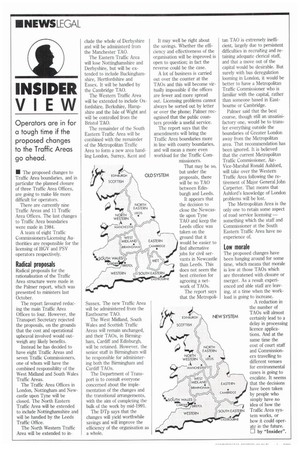INSIDER VIEW
Page 22

If you've noticed an error in this article please click here to report it so we can fix it.
Operators are in for a tough time if the proposed changes to the Traffic Areas go ahead.
IN The proposed changes to Traffic Area boundaries, and in particular the planned closure of three Traffic Area Offices, are going to make life more difficult for operators.
There are currently nine Traffic Areas and 11 Traffic Area Offices. The last changes to Traffic Area boundaries were made in 1984.
A team of eight Traffic Commissioners/Licensing Authorities are responsible for the licensing of HG V and PSV operators respectively.
Radical proposals
Radical proposals for the rationalisation of the Traffic Area structure were made in the Palmer report, which was presented to ministers last October.
The report favoured reducing the main Traffic Area Offices to four. However, the Transport Secretary rejected the proposals, on the grounds that the cost and operational upheaval involved would outweigh any likely benefits.
Instead he has decided to have eight Traffic Areas and seven Traffic Commissioners, one of whom will have the combined responsiblity of the West Midland and South Wales Traffic Areas.
The Traffic Area Offices in London, Nottingham and Newcastle upon Tyne will be closed. The North Eastern Traffic Area will be extended to include Nottinghamshire and will be handled by the Leeds Traffic Office.
The North Western Traffic Area will be extended to in dude the whole of Derbyshire and will be administerd from the Manchester TAO.
The Eastern Traffic Area will lose Nottinghamshire and Derbyshire, but will be extended to include Buckinghamshire, Hertfordshire and Essex. It will be handled by the Cambridge TAO.
The Western Traffic Area will be extended to include Oxfordshire, Berkshire, Hampshire and the Isle of Wight and will be controlled from the Bristol TAO.
The remainder of the South Eastern Traffic Area will be combined with the remainder of the Metropolitan Traffic Area to form a new area handling London, Surrey, Kent and Sussex. The new Traffic Area will be administered from the Eastbourne TAO.
The West Midland, South Wales and Scottish Traffic Areas will remain unchanged, and their TAOs, in Birmingham, Cardiff and Edinburgh, will be retained. However, the senior staff in Birmingham will be responsible for administering both the Birmingham and Cardiff TAOs.
The Department of Transport is to consult everyone concerned about the implementation of the changes and the transitional arrangements, with the aim of completing the bulk of the work by mid-1991.
The DTp says that the changes will yield worthwhile savings and will improve the efficiency of the organisation as a whole. It may well be right about the savings. Whether the efficiency and effectiveness of the organisation will be improved is open to question; in fact the reverse could be the case.
A lot of business is carried out over the counter at the TAOs and this will become virtually impossible if the offices are fewer and more spread out. Licensing problems cannot always be sorted out by letter or over the phone; Palmer recognised that the public counters provide a useful service.
The report says that the amendments will bring the Traffic Area boundaries more in line with county boundaries, and will mean a more even workload for the Traffic Com missioners.
That may be so, but under the proposals, there will be no TAO between Edinburgh and Leeds.
It appears that the decision to close the Newcastle upon Tyne TAO and keep the Leeds office was taken on the ground that it would be easier to find alternative jobs for civil servants in Newcastle than Leeds. This does not seem the best criterion for agreeing a network of TAOs.
The report says that the Metropoli tan TAO is extremely inefficient, largely due to persistent difficulties in recruiting and retaining adequate clerical staff, and that a move out of the capital would be desirable. But surely with bus deregulation looming in London, it would be better to have a Metropolitan Traffic Commissioner who is familiar with the capital, rather than someone based in Eastbourne or Cambridge.
Palmer said that the best course, though still an unsatisifactory one, would be to transfer everything outside the boundaries of Greater London away from the Metropolitan area. That recommendation has been ignored. It is believed that the current Metropolitan Traffic Commissioner, AirVice-Marshal Ronald Ashford, will take over the Western Traffic Area following the retirement of Major General John Carperter. That means that Ashford's knowledge of London problems will be lost.
The Metropolitan Area is the only one to retain some aspect of road service licensing — something which the staff and Commissioner at the South Eastern Traffic Area have no experience of.
Low morale
The proposed changes have been hanging around for some time, which means that morale is low at those TAOs which are threatened with closure or merger. As a result experienced and able staff are leaving, at a time when the workload is going to increase.
A reduction in the number of TAOs will almost certainly lead to a delay in processing licence applications. And at the same time the cost of court staff and Commissioners travelling to different venues for environmental cases is going to escalate. It seems that the decisions have been taken by people who simply have no idea of how the Traffic Area system works, or how it could operate in the future. 0 by "Insider".
















































































